Menus
- V2, 1868 cm3, 94 hp at 5020 rpm, 155 Nm at 3000 rpm, 306 kilos, from € 19,660
- Change of style and philosophy for this machine that migrates from the Dyna family to the Softail family
- Discovery
- In the saddle
- Engine and transmission
- In the city
- On motorways and main roads
- On departmental
- Part-cycle
- Brakes
- Comfort and duo
- Consumption / autonomy
- Conclusion
- Harley-Davidson Fat Bob Video Test
V2, 1868 cm3, 94 hp at 5020 rpm, 155 Nm at 3000 rpm, 306 kilos, from € 19,660
Change of style and philosophy for this machine that migrates from the Dyna family to the Softail family
A double break: here is what the Fat Bob at Harley-Davidson, in other words the machine of the rebels ! The first break is that of style: already, in 2008, the Fat Bob (code name FXDX for hardcore fans) contrasted with the usual productions of the Milwaukee brand, with its two headlights, its studded front tire. 130 mm wide and its 2 in 1 in 2 exhaust. Then, the machine evolved nicely in 2014, with some cosmetic details including in particular LED rear lights covered with a smoked and bevelled glass.
But here it is: "when things change, things change", wrote Michel Audiard for Les Tontons Flingueurs: for 2017, the Fat Bob changes and rather twice than once..
First, the look: are there any influences from Yamaha V-Max? Are there any influences from Ducati X-Diavel? It does not matter and these references are moreover rather flattering, because we are there in the world of muscle bikes with strong character and great potential. The second break, it is downright philosophical: the Fat Bob leaves the Dyna family to enter the world of Softail.
What does it change ? All. But be reassured: the essential is preserved. Explanations are below.
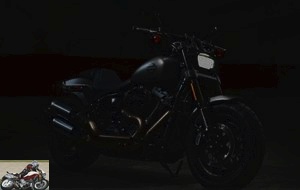
Discovery
Be careful, this is brutal! Harley did not want to keep the double optics of the previous model: instead, an LED headlight whose design seems to be inspired by a tank murderer! If the idea was to give it an aggressive look, it’s successful! Also seen, the generously sized studded tires (with a front 150/80 x 16, which makes you wonder if this machine is able to take turns!). Also seen, the exhaust, covered with a copper cowling in its central part and equipped with two satin silencer? Seen, the generous inverted fork (a first on this family of machines) and the double disc ?
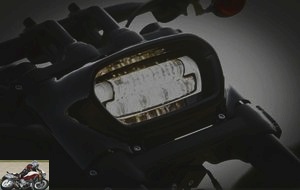
Nothing to say, all this is very aggressive and it is wanted, even successful. With this model, Harley-Davidson continues more than ever its break from the traditional codes of the brand and this bodes well for attracting new customers..

In addition, the Fat Bob 2017 is available with two engines: the 107 (1745 cm3), sold from € 17,860 and that of our test model, the 114 (1868 cm3), displayed from € 19,660.
In the saddle
With 710 mm of saddle height, the Fat Bob is quite accommodating, especially since the drag bar handlebars are not perched too far forward and the position of the footrests is mid-point. The saddle is well hollowed out: we will see later that this allows you to wedge up well during acceleration, which is copious..
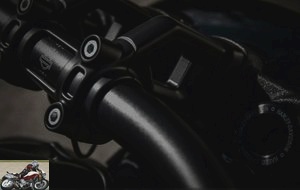
In front of you: a new counter assembly on a black painted center console. Sportiness obliges, the pride of place is given to the tachometer, with an on-board computer (fuel gauge, range, clock, two trips …) placed in the lower window. On the flip side, if you ride with a full-face helmet, the speed will eventually be difficult to read, because it is placed too low..
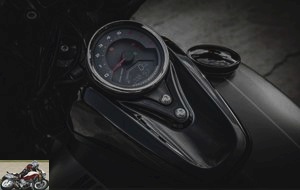
Engine and transmission
86 or 94 horsepower? Harley-Davidson gives the choice to the buyer to make his decision on the declination 107 ci (1745 cm3) or 114 ci (1868 cm3). The torque also increases, with, at 3000 rpm, 145 Nm or 155 Nm. Given the philosophical position of this machine, the powerful step motor is not a bad choice since it allows you to accelerate from 0 at 100 km / h 9% faster than with the 107 (itself being 10% faster than the previous Fat Bob with its 103 engine, from the previous generation). The difference between the two engines is 1800 €.
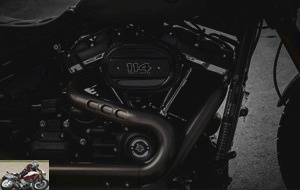
As with all new-generation Softails, the Fat Bob’s motor is mounted rigidly in the frame, but the motor has two balancing arms. The vibrations are nicely sensitive at idle, much less while driving. The engine is mated to a 6-speed gearbox and belt transmission.
In the city
We didn’t do a lot of town on this test, but the Fat Bob seduces with its compactness and its ability to make you forget that it weighs 306 kilos (16 kilos less than the previous generation, all the same!) . Thanks to a fairly low center of gravity, a relatively centralized driving position, the Fat Bob can be handled quite easily: admittedly, the 150 mm front tire requires a little arm in the tightest bends at low speed, but nothing crippling.
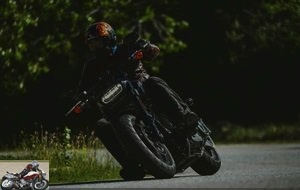
The V2 has length and flexibility too, if you know how to stroke it with the throttle: at the legal 50 km / h, it accepts to purr nonchalantly at 50 km / h at 2000 rpm in 3rd, but responds very quickly if you touch the handle.
On motorways and main roads
At 110 and 130 km / h, the V2 purrs at 2,500 and 3,000 rpm respectively in the last gear. Suffice to say that there is room. The nicely typed driving position makes it possible to fight against the elements without too much fatigue, with the new more rigid frame, the stability is not to be faulted and the kilometers could go by indefinitely, if only the monotonous aspect of the thing. In any case, it is not because of the engine that one gets bored, because the unit 114 continues to surprise and to amaze by its resource. With him, the times are copious and the overtaking is only a formality.

On departmental
How to see things? In cruising mode? In this case, we still appreciate as much and the compliments continue to flow, this block 114 which knows how to be suave on a trickle of gas and nasty when it is tickled by the handle. Well wedged in the saddle, we take advantage of the landscape while enjoying cannon shots, from time to time.
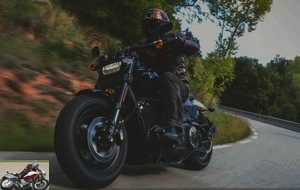
However, there is a new register opening up to the Fat Bob’s skills book: that of dynamic driving. We’re not going to say sporty, no (94 hp for 305 kilos, all the same), but dynamic, yes. Because the Fat Bob accepts to be abrupt. "This is the first Harley-Davidson that you can ride like a jerk," a colleague told me, whose name I will keep out of charity. The first, maybe not: there were the V-Rods before as well as the XR1200. Nevertheless, we can drive it in a cheerful way and get it off.
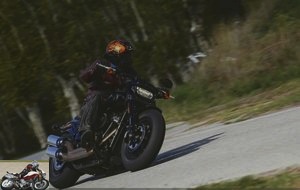
The ground clearance is given for 31 ° to the right and 32 ° to the left: it does not seem like nothing, but in fact we can take a lot of angle without rubbing and it is only in insisting that the machine ends up making contact with the bitumen. And without breaking apart, thanks to the chassis that is much more rigid than in the past. With the very muscular pick-ups of the 114 engine, this allows the terrain to not be entertained on winding roads. !
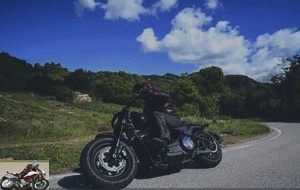
Part-cycle
These new Softails all have in common the central part of the frame, where the rear shock makes the junction between the backbone and the top of the swingarm, in place of the two shocks placed under the frame and which worked in extension. Then, Harley has three caster angles (the Fat Bob is in "closed" mode, at 28 °, two triple tree widths (here, it’s wide), two swingarm widths (also, which allows ‘have a remote dial for adjusting the rear shock absorber). And the weight gains 14 kilos compared to the previous generation.

Compared to the previous Softail, the new frame provides a stiffness gain of 34%. Even stronger and that interests us directly, it is 75% more rigid than that of previous Dyna !
We will of course have recognized the presence of an inverted fork, unique to the Softail range..
Brakes
Another new assembly: a double disc brake with 4-piston calipers, just like at the rear. The ABS becomes sensitive on big, heavy braking (it must be said that the bike remains heavy and that we arrive strong), but overall, the power and the braking dosage do not call for criticism..

Comfort and duo
For the pilot, the comfort is very correct: the driving position is quite natural, we do with the lack of wind protection, the saddle is soft and the suspensions do their job very well, at the front as well as at the back. On the other hand, the small saddle reserved for the passenger is downright hard and, on the right, the exhausts can constitute a small annoyance. Suddenly, it will be in your interest to choose a petite and loving passenger, which is always more interesting than a big unfriendly heap and who is only after your money..
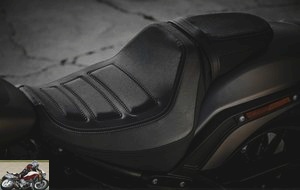
Consumption / autonomy
The tank has seen its capacity drop: we are now at 13.6 l, instead of 18.9 l. This will not please backpackers, who will console themselves with the measured consumption of the Big Twin and the announced autonomy which borders on 270 kilometers. Not so bad !
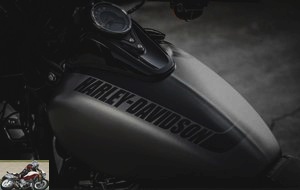
Conclusion
As the Fat Bob is intended to be a motorcycle of conquest, the question that may arise is therefore whether a fan of, say at random, a Japanese sports roadster can pass on this machine. The answer is unequivocally yes, a thousand times yes! Because, in a stylistic and sensory universe apart, the Fat Bob has the immense merit of being fun and letting jostle on small roads.
More than ever, its look enters the world of muscle bikes, with its stocky appearance and its neat surface coatings. Easy to drive, easy to handle despite its large tires of unusual dimensions, the Fat Bob shows and it is a surprise that it can be completely jostled in bends, which makes it possible to understand the importance of new Softail frames and their stiffness gain.
No doubt this machine will play an important role in customer rejuvenation !
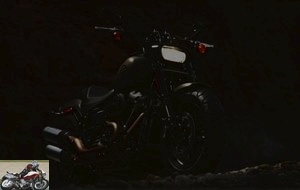
Strong points
- Really punchy engine
- Radical and successful look
- Ease of handling
- Driving pleasure, even when driving fast
- Rigid and healthy frame
- Efficient braking
Weak points
- Barely readable counter
- Decreased autonomy
- Passenger comfort
- Rear cylinder heat rises
The Harley-Davidson Fat Bob technical sheet
Test conditions
- Itinerary: a hundred kilometers on mountainous roads in the region of Barcelona
- Motorcycle mileage: 1,600 km
- Problem encountered: none
Competition: Yamaha V-Max, Ducati X-Diavel, Triumph 1700 Thunderbird Storm
Harley-Davidson Fat Bob Video Test
Related articles
-
Harley-Davidson Breakout 114 test
V2, 1,868 cm3, 94 hp at 5,020 rpm, 155 Nm at 3,000 rpm, 305 kilos, from € 21,760 Harley’s bestseller has all the cards in hand to pursue a flamboyant…
-
Roadster with Sugomi sauce or decarenated sports car A2 licenses have the choice between large bridles, sometimes very badly bridled, and smaller ones,…
-
A power cruiser with Italian sauce. Punch, style, noise, character ! V2 1262 cm3, 152 hp at 9,500 rpm, 12.8 m / kg at 5,000 rpm, 220 kilos dry, from…
-
4 cylinders in line, 948 cm3, 111 hp at 8,500 rpm, 10 m / kg at 6,500 rpm, 215 kilos, from € 11,999 A skillfully modified Z 900 or the worthy heir to the…
-
Fine-tuning in order You don’t change a recipe that works. The second generation of the Ducati Diavel therefore evolves only on points of detail while…
-
Seriously wanton ! The BMW S 1000 R, the “string and tall handlebar” version of its in-house superbike, has strong arguments to make a place for itself…
-
Lumberjack power A BMW X5 stops next to me, looks at the motorcycle. Husqvarna? I thought they were just chainsaws! Well yes, it’s a lumberjack’s…
-
40 horses at 11,500 rpm 25.7 Nm, 175 kilos with full tank, two colors, € 5,799 An easy and sparkling little trail: what if life on a motorcycle was as…
-
4 cylinders in line, compressor, 998 cm3, 210 hp at 11,000 rpm, 137.3 Nm at 9,500 rpm, 260 kilos, € 21,999 Kawasaki reinvents the super-fast and…
-
Alternative American-style engineering 3 cylinders in W at 45 ° x 45 °, 2.472 cm3, 154 hp, 236 Nm, 268 kg California is teeming with talented tuners, all…